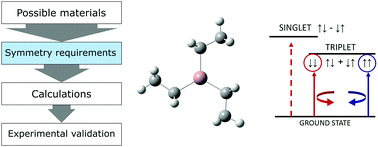Symmetry based molecular design for triplet excitation and optical spin injection†
Abstract
Spintronics, as a relatively new scientific field, is developing rapidly together with our understanding of spin related phenomena and spin manipulation. One of the challenges in the field is spin injection, which has been achieved optically in inorganic crystalline semiconductors, but not yet in organic semiconductors. Here, we introduce an approach whereby we apply group theory and computational methods to design molecular materials in which spin can be injected optically via circularly polarized light (CPL). Our approach is based on the use of group theory and double group theory to identify families of molecules whose symmetry satisfies design rules for optical excitation of triplets of particular properties. Employing such screening prior to detailed calculation can accelerate design by first identifying any structures that fail some criterion on grounds of symmetry. Here, we show using group theory and computational methods that particular families of molecules possess a low lying triplet state that can be excited with circularly polarized light causing spin polarization of an excited electron. Such structures are of potential interest for organic or molecular spintronics. We present an efficient procedure to identify candidate point groups and determine the excited state symmetry using group theory, before full calculation of excited states using relativistic quantum chemistry.



 Please wait while we load your content...
Please wait while we load your content...